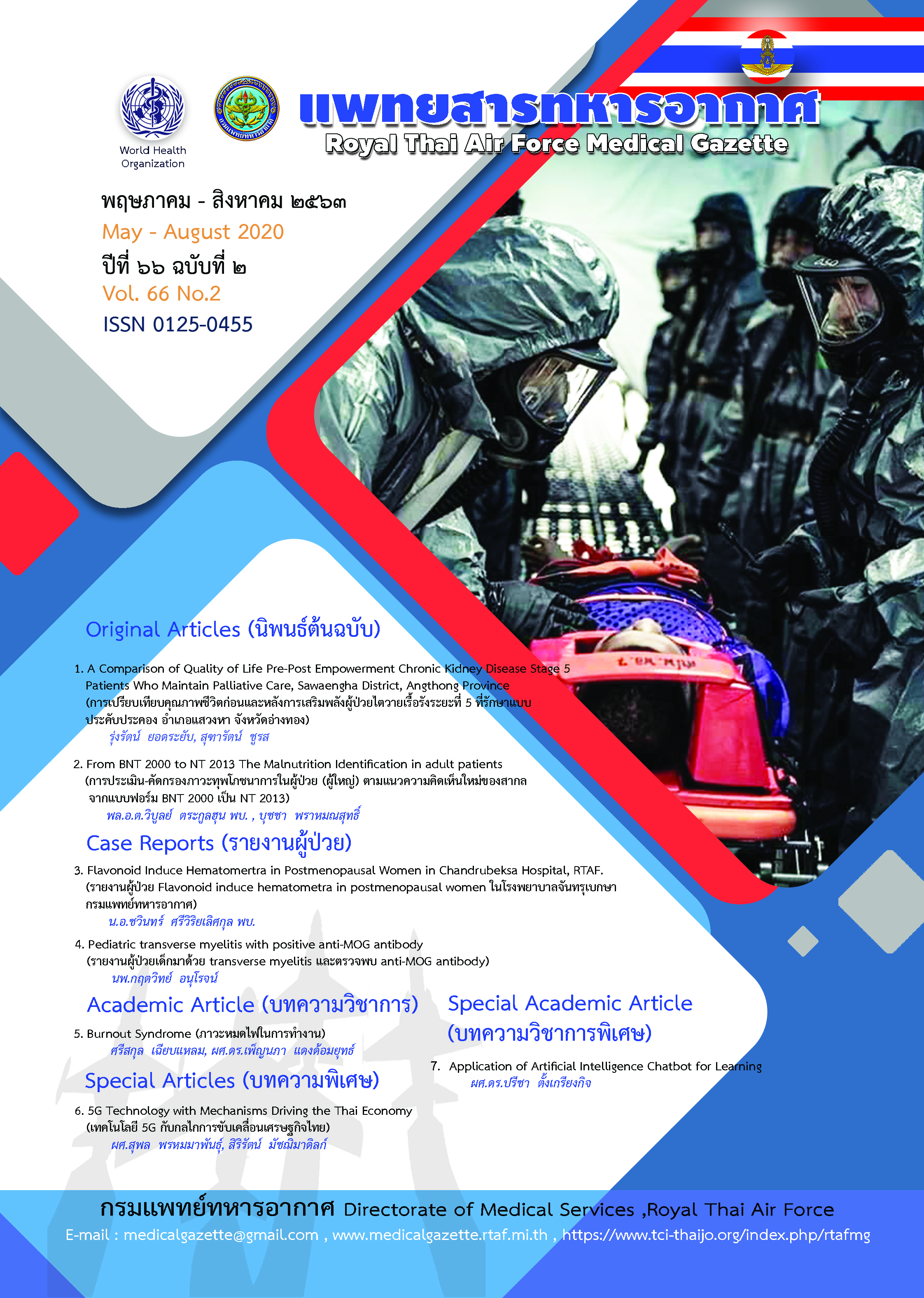A Comparison of Quality of Life Pre-Post Empowerment Chronic Kidney Disease Stage 5 Patients Who Maintain Palliative Care, Sawaengha District, Angthong Province
Main Article Content
Abstract
This research is pre experimental research. The purpose of this study was to compare the quality of life of patients with chronic renal failure phase 5 with palliative care before and after empowerment. The sample group was Palliative renal failure patients, stage 5, who received palliative treatment (eGFR <15 mL. per minute, 1.73 square meters) which rejected renal replacement therapy, Sawaeng Ha District, Ang Thong Province, totaling 31 cases. The tools used in the research were 1. Media / brochure for knowledge about kidney disease / video / manual for being happy with kidney disease / prototype / food and medicine model. / Self-Empowerment Program. 2. Data collection tools used questionnaire consisting of 2 parts: part 1, personal data questionnaire, part 2 The World Health Organization’s Quality of Life Questionnaire, Thai version (WHOQOL-BREF-THAI), is a opinion level questionnaire that has been verified for content validity by experts. Verification of confidence (Reliability) Data were collected by interviewing samples between January 1, 2019 and March 31, 2019. Data were analyzed using descriptive statistics such as percentage, mean, standard deviation and inferential statistics including Dependent t-test as follows.
The results of the quality of life of the sample group in this research were mostly female aged between 70-79. Most years by average age 79 Years of education, most of them are elementary, professional, agricultural, with an average monthly income of 1,000-3,000 baht, which is money for the elderly, government benefits, and having common diseases, diabetes and high blood pressure. Spouses or children, the comparison of the samples has a quality of life score before powering up 74.7 after powering up 82.0. The quality of life increased by 7.23 and when tested for statistical differences, it was found that the quality of life after the empowerment increased significantly at p <0.05. In summary, the differences in each aspect showed that the quality of life scores of each target group were different, ie, after enhancing the level of quality of life scores in every aspect significantly increased. At the level of p <0.05.
From the above study, it can be concluded that The concept of empowerment contributes to the better quality of life of patients. Therefore, the empowerment approach should be applied together with the normal treatment of patients with chronic renal failure stage 5 to be useful in Being a guideline for promoting quality of life and improving patient care Improving the quality of life of patients both physically, mentally, socially and environmentally.
Article Details
บทความที่ได้รับการตีพิมพฺเป็นลิขสิทธิ์ของวารสาร
References
คณะเภสัชศาสตร์ มหาวิทยาลัย มหิดล;2560.
2. Gibson, C.H.A study of empowerment in mothers of chronically ill children Boston : Boston Collage; 1993:113.
3. The WHOQOL Group. The development of The World Health Organization Quality of Life Assessment
Instrument (WHOQOL). In :Orley J, Kuyken W, editors. Quality of Life assessment international
prospective.Berlin : Spingerverlay;1993:41-57.
4. สำนักนโยบายและยุทธศาสตร์. ยุทธศาสตร์กระทรวงสาธารณสุข.bps.moph.go.th/newbps/sites/default/files/mophplan_
2559_final_0.pdf. สืบค้นเมื่อวันที่ 25 พฤศจิกายน 2561.
5. สำนักโรคไม่ติดต่อกรมควบคุมโรค กระทรวงสาธารณสุข. (2558). ข้อมูลโรคไม่ติดต่อเรื้อรัง http://thaincd.com/infrmation-
statistic/non-commu-nicable-disease-data.phpMpn=2. สืบค้นวันที่ 25 พฤศจิกายน 2561.
6. กิติมาเศรษฐ์บุญสร้าง, ประเสริฐประสมรักษ์. การพัฒนารูปแบบการดูแลของผู้ป่วยโรคไตวายเรื้อรังระยะสุดท้าย ที่ได้รับการบาบัด
ทดแทนไตต่อพฤติกรรมการดูแลตนเองและคุณภาพชีวิตผู้ป่วยโรงพยาบาลสมเด็จพระยุพราชเลิงนกทา จังหวัดยโสธร. วารสารการ
พัฒนา สุขภาพชุมชน มหาวิทยาลัยขอนแก่น 2559:485-503.
7. กิตติยาภรณ์ โชคสวัสดิภิญโญ. การเสริมสร้างพลังอำนาจผู้ดูแลในครอบครัวต่อการพัฒนาคุณภาพชีวิตผู้ติดเชื้อเอชไอ วี/ผู้ป่วยเอดส์.
วารสารงานวิจัยคณะวิทยาศาสตร์ มหาวิทยาลัยราชภัฏอุดรธานี 2559;16:416-27.
8. วัชริน แน่นหนา, สมชาย ยงศิริ, ปาริดา คำฟูบุตร. การศึกษาภาวะสุขภาพของผู้ป่วยล้างไตทางช่องท้องที่รับการรักษาในโรงพยาบาล
มหาวิทยาลัยบูรพา. วิทยานิพนธ์ปริญญามหาบัณฑิต สาขาวิทยาศาสตร์การแพทย์. ชลบุรี มหาวิทยาลัยบูรพา; 2556.
9. รุจิราพร ป้องเกิด. ผลของการเสริมสร้างพลังอำนาจต่อพฤติกรรมการดูแลตนเองของผู้สูงอายุโรคไตเรื้อรังที่ได้รับการรักษาด้วยการล้าง
ไตทางหน้าท้องอย่างต่อเนื่อง. คลังปัญญาจุฬาสาขาวิชาพยาบาลศาสตร์ คณะพยาบาลศาสตร์จุฬาลงกรณ์มหาวิทยาลัย; 2557.
10. วนิดา วิชัยศักดิ์. การศึกษาเปรียบเทียบคุณภาพชีวิตระหว่างกลุ่มผู้ป่วยโรคไตวายเรื้อรังระยะสุดท้ายที่รักษาด้วยการฟอกเลือด การล้าง
ไตทางช่องท้องและกลุ่มผู้ป่วยโรคไตวายเรื้อรังระยะสุดท้ายที่ได้รับการผ่าตัดเปลี่ยนไตที่คลินิกโรคไตแผนกอายุรกรรม
ในโรงพยาบาลจุฬาลงกรณ์. วิทยานิพนธ์ปริญญาวิทยาศาสตรมหาบัณฑิต สาขาวิชาสุขภาพจิต ภาควิชาจิตเวชศาสตร์ คณะแพทย์ศาสตร์ จุฬาลงกรณ์มหาวิทยาลัย; 2559.
11. สมาคมโรคไตแห่งประเทศไทย. คำแนะนำสำหรับการดูแลผู้ป่วยโรคไตเรื้อรังก่อนการบำบัดทดแทนไต. สำนักงานหลักประกันสุขภาพแห่งชาติ (สปสช.); 2558.


